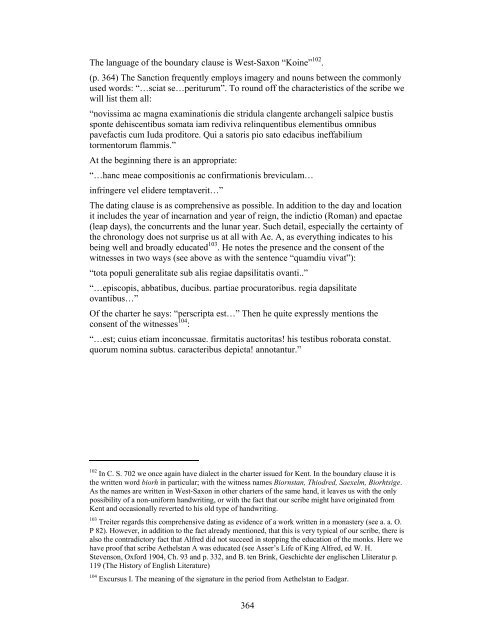Provisional Drogereit pdf
Provisional Drogereit pdf
Provisional Drogereit pdf
Create successful ePaper yourself
Turn your PDF publications into a flip-book with our unique Google optimized e-Paper software.
The language of the boundary clause is West-Saxon “Koine” 102 .<br />
(p. 364) The Sanction frequently employs imagery and nouns between the commonly<br />
used words: “…sciat se…periturum”. To round off the characteristics of the scribe we<br />
will list them all:<br />
“novissima ac magna examinationis die stridula clangente archangeli salpice bustis<br />
sponte dehiscentibus somata iam rediviva relinquentibus elementibus omnibus<br />
pavefactis cum Iuda proditore. Qui a satoris pio sato edacibus ineffabilium<br />
tormentorum flammis.”<br />
At the beginning there is an appropriate:<br />
“…hanc meae compositionis ac confirmationis breviculam…<br />
infringere vel elidere temptaverit…”<br />
The dating clause is as comprehensive as possible. In addition to the day and location<br />
it includes the year of incarnation and year of reign, the indictio (Roman) and epactae<br />
(leap days), the concurrents and the lunar year. Such detail, especially the certainty of<br />
the chronology does not surprise us at all with Ae. A, as everything indicates to his<br />
being well and broadly educated 103 . He notes the presence and the consent of the<br />
witnesses in two ways (see above as with the sentence “quamdiu vivat”):<br />
“tota populi generalitate sub alis regiae dapsilitatis ovanti..”<br />
“…episcopis, abbatibus, ducibus. partiae procuratoribus. regia dapsilitate<br />
ovantibus…”<br />
Of the charter he says: “perscripta est…” Then he quite expressly mentions the<br />
consent of the witnesses 104 :<br />
“…est; cuius etiam inconcussae. firmitatis auctoritas! his testibus roborata constat.<br />
quorum nomina subtus. caracteribus depicta! annotantur.”<br />
102 In C. S. 702 we once again have dialect in the charter issued for Kent. In the boundary clause it is<br />
the written word biorh in particular; with the witness names Biornstan, Thiodred, Saexelm, Biorhtsige.<br />
As the names are written in West-Saxon in other charters of the same hand, it leaves us with the only<br />
possibility of a non-uniform handwriting, or with the fact that our scribe might have originated from<br />
Kent and occasionally reverted to his old type of handwriting.<br />
103 Treiter regards this comprehensive dating as evidence of a work written in a monastery (see a. a. O.<br />
P 82). However, in addition to the fact already mentioned, that this is very typical of our scribe, there is<br />
also the contradictory fact that Alfred did not succeed in stopping the education of the monks. Here we<br />
have proof that scribe Aethelstan A was educated (see Asser’s Life of King Alfred, ed W. H.<br />
Stevenson, Oxford 1904, Ch. 93 and p. 332, and B. ten Brink, Geschichte der englischen Lliteratur p.<br />
119 (The History of English Literature)<br />
104 Excursus I. The meaning of the signature in the period from Aethelstan to Eadgar.<br />
364
















